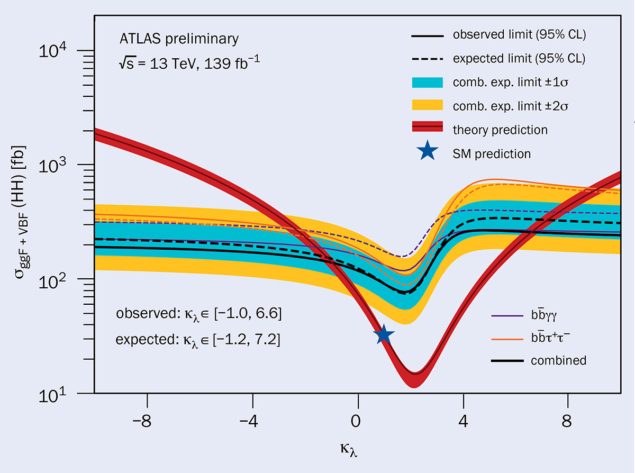A report from the ATLAS experiment.

The discovery of the Higgs boson and the comprehensive measurements of its properties provide a strong indication that the mechanism of electroweak symmetry breaking (EWSB) is compatible with the one predicted by Brout, Englert and Higgs (BEH) in 1964. But there remain unprobed features of EWSB, chiefly whether the form of the BEH potential follows the predicted “Mexican hat” shape. One of the parameters that determines the form of the BEH potential is the Higgs boson’s trilinear self-coupling, λ. Experimentally, this fundamental parameter can be measured via Higgs-boson pair (HH) production, where a single virtual Higgs boson splits into two Higgs bosons. However, such a measurement is very challenging as the Standard Model (SM) HH production cross-section is more than 1000 times lower than that of single Higgs-boson production.
Beyond the SM (BSM) physics with modified or new Higgs-boson couplings could lead to significantly enhanced HH production. Some BSM scenarios predict new heavy particles that may lead to resonant HH production, contrary to the non-resonant production featured by the triple-Higgs-boson coupling. New ATLAS results set tight constraints on both the non-resonant and resonant scenarios, showing that the boundaries of what can be achieved with the current and future LHC datasets can be significantly pushed.
The ATLAS collaboration recently released results of searches for HH production in three final states – bbγγ, bbττ and 4b (where one Higgs boson decays into two b-quarks and the other into two photons, two tau-leptons or two b-quarks) and their combination, exploiting the full LHC Run-2 dataset. The first two analyses target both resonant and non-resonant HH production, while the 4b analysis targets only resonant HH production. These three channels are the most sensitive final states in each scenario. The three decay modes of the second Higgs boson provide good sensitivity in different kinematic regions, so that the analyses are highly complementary. The HH → bbγγ process has the lowest branching ratio but high efficiency to trigger and reconstruct photons, as well as an excellent diphoton mass resolution, leading to the best sensitivity at low HH invariant masses. The HH → 4b final state has the highest branching ratio but suffers from the requirement to impose high transverse momentum b-jet trigger thresholds, the ambiguity in the Higgs boson reconstruction and the large multijet background. However, it provides the best sensitivity at high HH invariant masses. Finally, the HH → bbττ decay has a moderate branching ratio as well as a moderate background contamination, giving the best sensitivity in the intermediate HH mass range.
BSM physics with new Higgs-boson couplings could lead to significantly enhanced HH production
With the latest analyses, a remarkably stringent observed (expected) upper limit of 3.1 (3.1) times the SM prediction on non-resonant HH production was obtained at 95% confidence level (CL). The coupling strength of the Higgs boson trilinear self-coupling in units of the SM value κλ is observed (expected) to be constrained between –1.0 and 6.6 (–1.2 and 7.2) at 95% CL (see figure 1). These are the world’s tightest constraints obtained on this process. The observed (expected) exclusion limits at 95% CL on the resonant HH production cross-section range between 1.1 and 595 fb (1.2 and 392 fb) for resonance masses between 250 and 5000 GeV.
The sensitivity of the current analyses is still limited by statistical uncertainties and is expected to improve significantly with the future luminosity increase during LHC Run 3 and the HL-LHC programme. A comparison between the current results and previous partial Run-2 dataset results has shown that an improvement by more than a factor of three on the limits is achieved. A factor of two was expected from the larger dataset, and the remaining improvements arise from better object reconstruction and identification techniques, and new analysis methods.
These latest results inspire confidence that the observation of the SM HH production and a precise measurement of the Higgs-boson trilinear self-coupling may be possible at the HL-LHC.
Further reading
ATLAS Collab. 2021 arXiv:2112.11876.
ATLAS Collab. 2021 ATLAS-CONF-2021-030.
ATLAS Collab. 2022 arXiv:2202.07288.
ATLAS Collab. 2021 ATLAS-CONF-2021-052.





